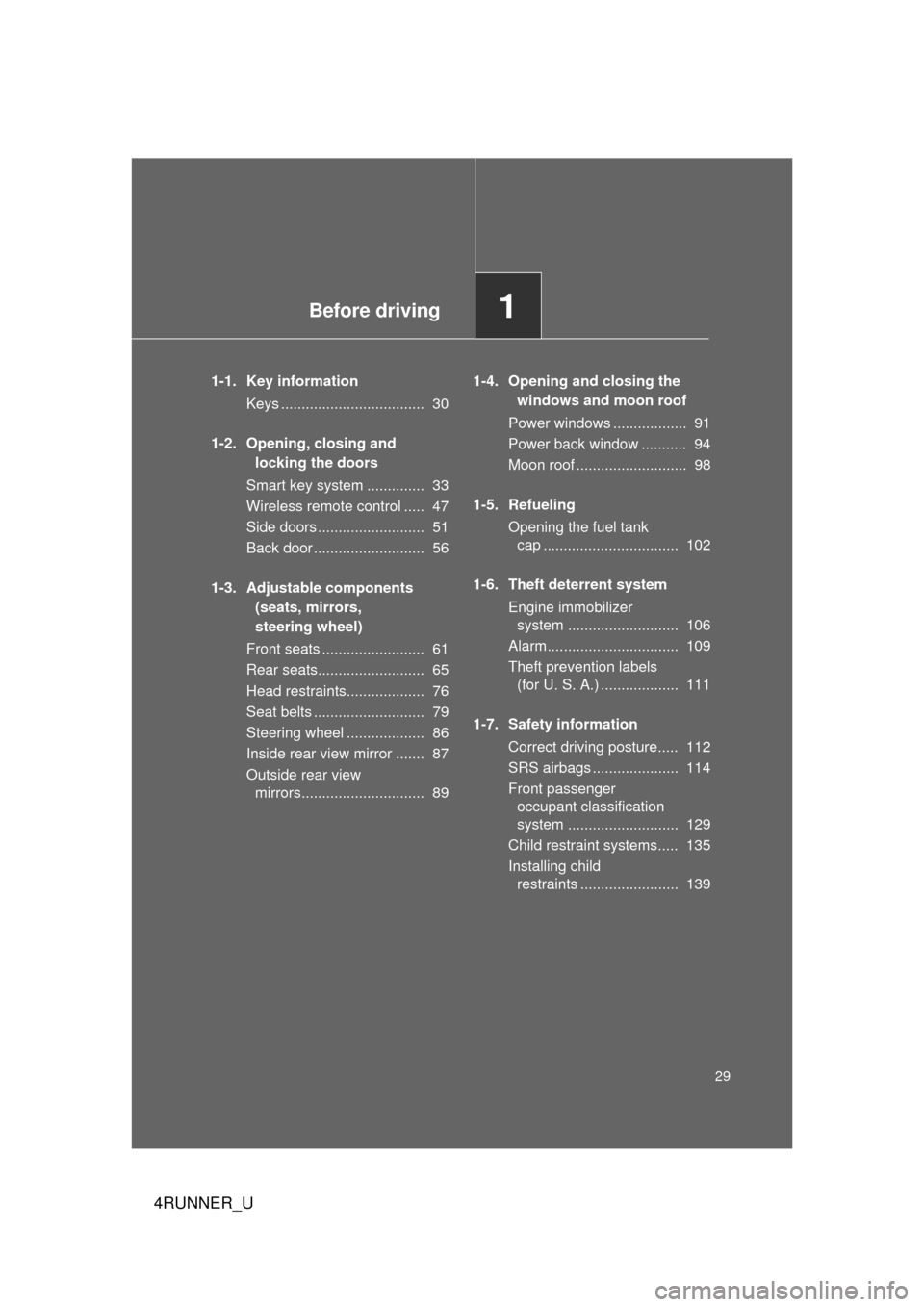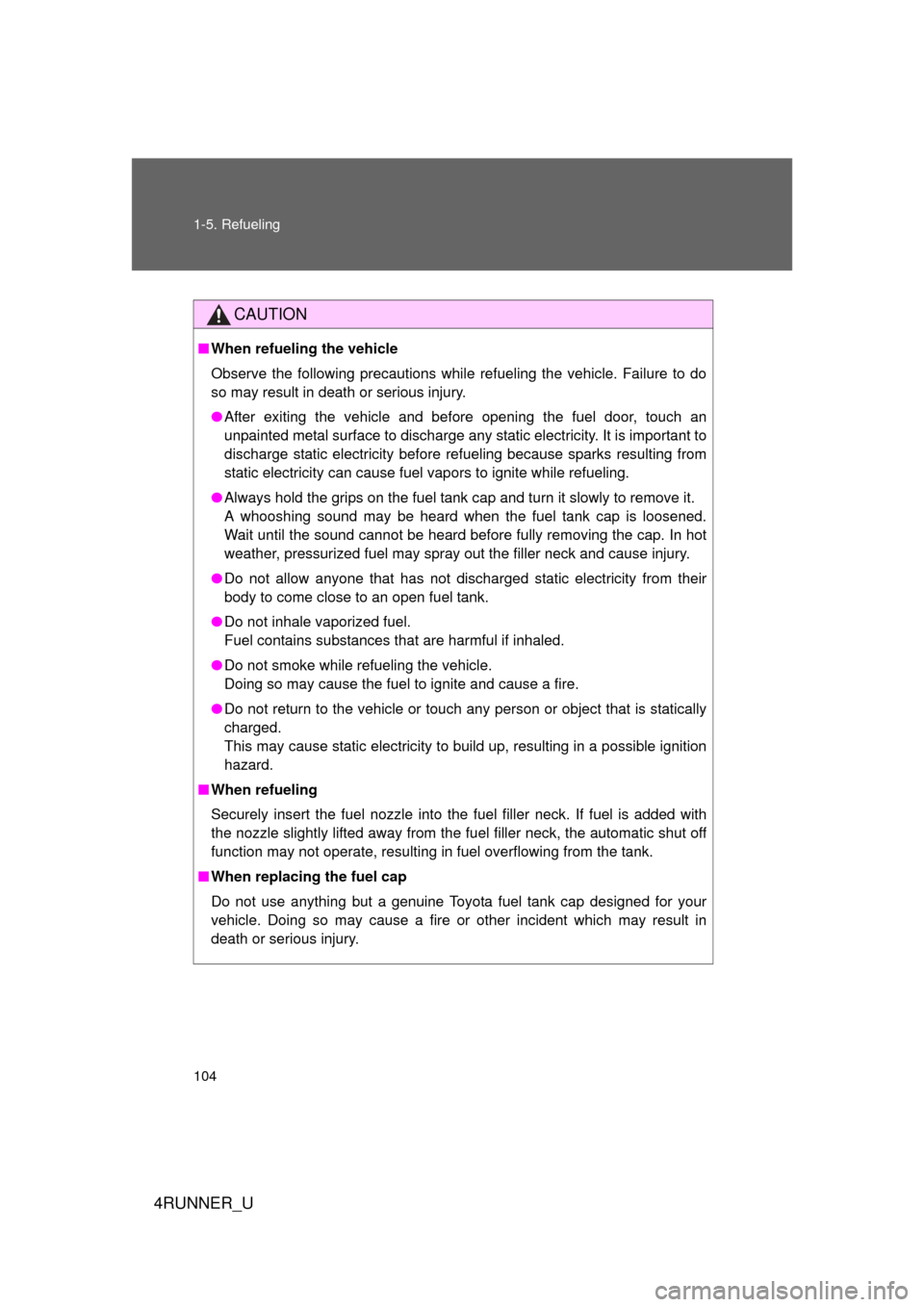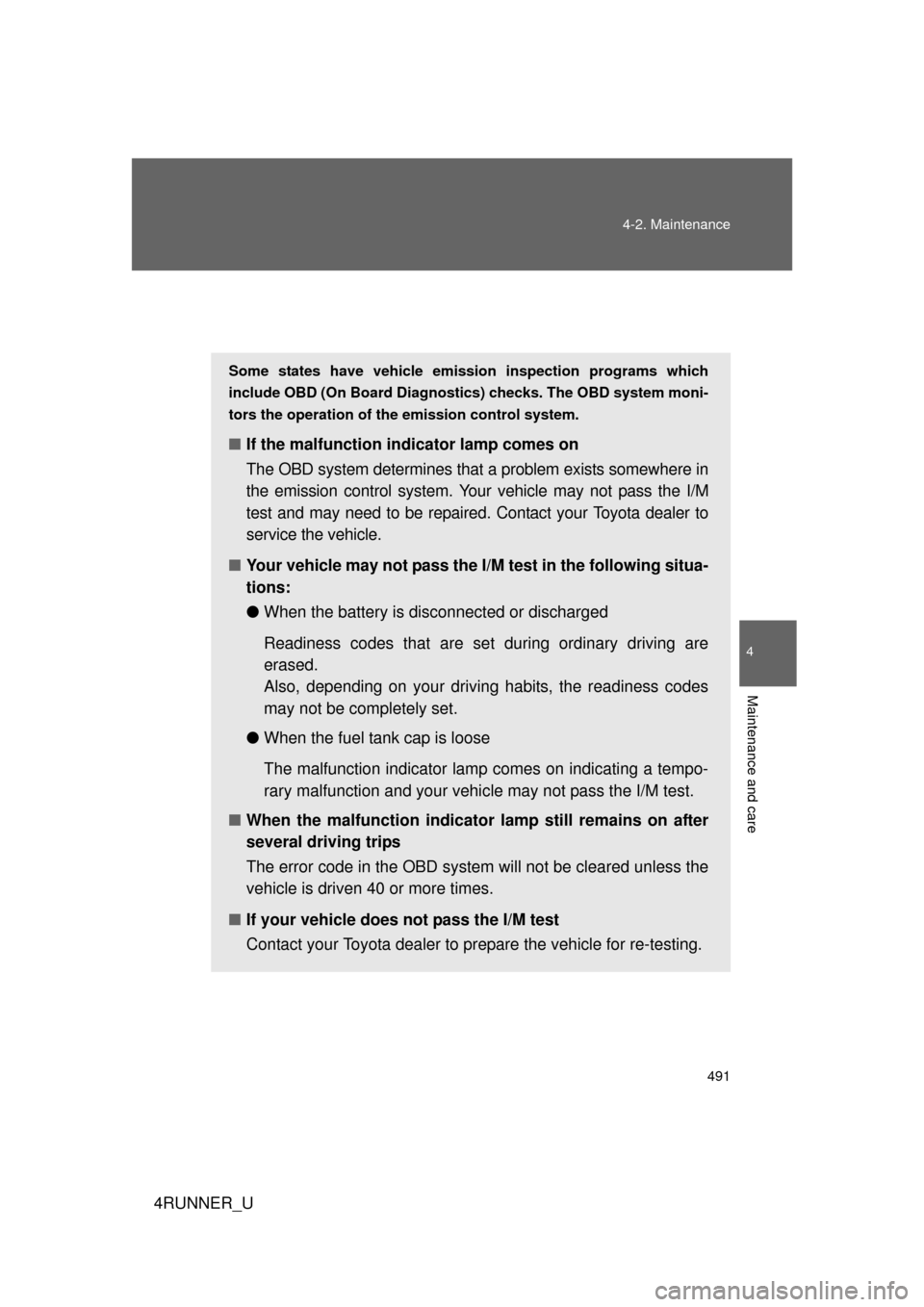Page 2 of 665

TABLE OF CONTENTSIndex
4RUNNER_U
2
1-1. Key informationKeys ..................................... 30
1-2. Opening, closing and locking the doors
Smart key system................. 33
Wireless remote control ....... 47
Side doors ............................ 51
Back door ............................. 56
1-3. Adjustable components (seats, mirrors,
steering wheel)
Front seats ........................... 61
Rear seats ............................ 65
Head restraints ..................... 76
Seat belts ............................. 79
Steering wheel ..................... 86
Inside rear view mirror.......... 87
Outside rear view mirrors ..... 89
1-4. Opening and closing the windows and moon roof
Power windows .................... 91
Power back window ............. 94
Moon roof ............................. 98
1-5. Refueling Opening the fuel tank cap ................................... 102 1-6. Theft deterrent system
Engine immobilizer system .............................. 106
Alarm .................................. 109
Theft prevention labels (for U. S. A.) ..................... 111
1-7. Safety information Correct driving posture ....... 112
SRS airbags ....................... 114
Front passenger occupant classification system ......... 129
Child restraint systems ....... 135
Installing child restraints ..... 139
2-1. Driving procedures Driving the vehicle .............. 154
Engine (ignition) switch (vehicles without a
smart key system) ............ 164
Engine (ignition) switch (vehicles with a smart
key system) ...................... 167
Automatic transmission ...... 173
Turn signal lever ................. 179
Parking brake ..................... 180
Horn .................................... 181
1Before driving
2When driving
Page 29 of 665

Before driving1
29
4RUNNER_U
1-1. Key informationKeys ................................... 30
1-2. Opening, closing and locking the doors
Smart key system .............. 33
Wireless remote control ..... 47
Side doors .......................... 51
Back door ........................... 56
1-3. Adjustable components (seats, mirrors,
steering wheel)
Front seats ......................... 61
Rear seats.......................... 65
Head restraints................... 76
Seat belts ........................... 79
Steering wheel ................... 86
Inside rear view mirror ....... 87
Outside rear view mirrors.............................. 89 1-4. Opening and closing the
windows and moon roof
Power windows .................. 91
Power back window ........... 94
Moon roof ........................... 98
1-5. Refueling Opening the fuel tank cap ................................. 102
1-6. Theft deterrent system Engine immobilizer system ........................... 106
Alarm................................ 109
Theft prevention labels (for U. S. A.) ................... 111
1-7. Safety information Correct driving posture..... 112
SRS airbags ..................... 114
Front passenger occupant classification
system ........................... 129
Child restraint systems..... 135
Installing child restraints ........................ 139
Page 102 of 665
102
4RUNNER_U
1-5. Refueling
Opening the fuel tank cap
Perform the following steps to open the fuel tank cap:
■Before refueling the vehicle
Vehicles without a smart key system
Turn the engine switch off and ensure that all the doors and win-
dows are closed.
Vehicles with a smart key system
Turn the “ENGINE START STOP” switch off and ensure that all
the doors and windows are closed.
■ Opening the fuel tank cap
Open the fuel filler door.
Turn the fuel tank cap slowly
to open.
CTH15AS001
STEP 1
CTH15AS002
STEP 2
Page 103 of 665
103
1-5. Refueling
1
Before driving
4RUNNER_U
Closing the fuel tank cap
After refueling, turn the fuel tank
cap until you hear a click. Once
the cap is released, it will turn
slightly in the opposite direction.
Hang the fuel tank cap on the
back of the fuel filler door.
CTH15AS003
STEP 3
CTH15AS004
Page 104 of 665

104 1-5. Refueling
4RUNNER_U
CAUTION
■When refueling the vehicle
Observe the following precautions while refueling the vehicle. Failure to do
so may result in death or serious injury.
● After exiting the vehicle and before opening the fuel door, touch an
unpainted metal surface to discharge any static electricity. It is important to
discharge static electricity before refueling because sparks resulting from
static electricity can cause fuel vapors to ignite while refueling.
● Always hold the grips on the fuel tank cap and turn it slowly to remove it.
A whooshing sound may be heard when the fuel tank cap is loosened.
Wait until the sound cannot be heard before fully removing the cap. In hot
weather, pressurized fuel may spray out the filler neck and cause injury.
● Do not allow anyone that has not discharged static electricity from their
body to come close to an open fuel tank.
● Do not inhale vaporized fuel.
Fuel contains substances that are harmful if inhaled.
● Do not smoke while refueling the vehicle.
Doing so may cause the fuel to ignite and cause a fire.
● Do not return to the vehicle or touch any person or object that is statically
charged.
This may cause static electricity to build up, resulting in a possible ignition
hazard.
■ When refueling
Securely insert the fuel nozzle into the fuel filler neck. If fuel is added with
the nozzle slightly lifted away from the fuel filler neck, the automatic shut off
function may not operate, resulting in fuel overflowing from the tank.
■ When replacing the fuel cap
Do not use anything but a genuine Toyota fuel tank cap designed for your
vehicle. Doing so may cause a fire or other incident which may result in
death or serious injury.
Page 267 of 665
267
2-5. Driving information
2
When driving
4RUNNER_U
Cargo and luggage
Take notice of the following information about storage precau-
tions, cargo capacity and load:
●Stow cargo and luggage in the luggage compartment whenever
possible.
● Be sure all items are secured in place.
● To maintain vehicle balance while driving, position luggage
evenly within the luggage compartment.
● For better fuel economy, do no t carry unnecessary weight.
Page 491 of 665

491
4-2. Maintenance
4
Maintenance and care
4RUNNER_U
Emission inspection and maintenance (I/M) programs
Some states have vehicle emission inspection programs which
include OBD (On Board Diagnostics) checks. The OBD system moni-
tors the operation of th
e emission control system.
■If the malfunction indicator lamp comes on
The OBD system determines that a problem exists somewhere in
the emission control system. Your vehicle may not pass the I/M
test and may need to be repaired. Contact your Toyota dealer to
service the vehicle.
■ Your vehicle may not pass the I/M test in the following situa-
tions:
●When the battery is disconnected or discharged
Readiness codes that are se t during ordinary driving are
erased.
Also, depending on your driving habits, the readiness codes
may not be completely set.
● When the fuel tank cap is loose
The malfunction indicator lamp comes on indicating a tempo-
rary malfunction and your vehi cle may not pass the I/M test.
■ When the malfunction indicator lamp still remains on after
several driving trips
The error code in the OBD system will not be cleared unless the
vehicle is driven 40 or more times.
■ If your vehicle does not pass the I/M test
Contact your Toyota dealer to prepare the vehicle for re-testing.
Page 523 of 665

522 4-3. Do-it-yourself maintenance
4RUNNER_U
■Effects of incorrect tire inflation pressure
Driving with incorrect tire inflation pressure ma y result in the following:
●Reduced fuel efficiency
●Reduced driving comfort and tire life
●Reduced safety
●Damage to the drive train
If a tire needs frequent inflating, have it checked by your Toyota dealer.
■Instructions for checking tire inflation pressure
When checking tire inflation pressure, observe the following:
●Check only when the tires are cold.
If your vehicle has been parked for at least 3 hours or has not been
driven for more than 1 mile or 1.5 km, you will get an accurate cold
tire inflation pressure reading.
●Always use a tire pressure gauge.
The appearance of the tire can be mi sleading. In addition, tire infla-
tion pressure that is even just a few pounds off can affect ride quality
and handling.
●Do not reduce tire inflation pressure after driving. It is normal for tire
inflation pressure to be higher after driving.
●Never exceed the vehicle capacity weight.
Passengers and luggage weight should be placed so that the vehicle
is balanced.